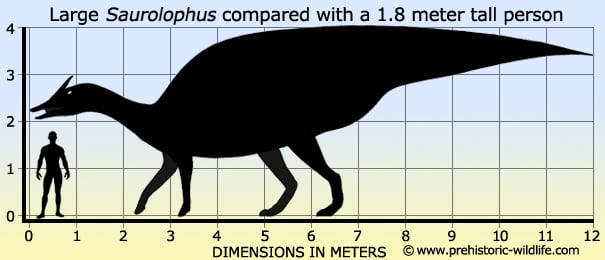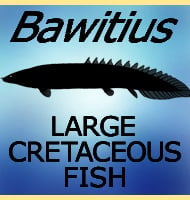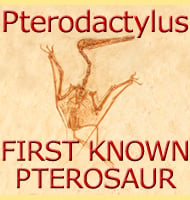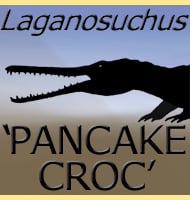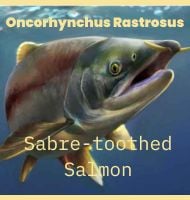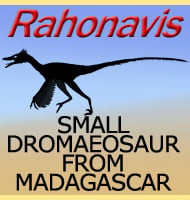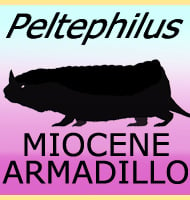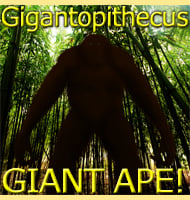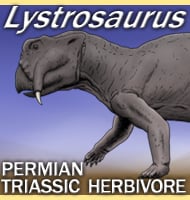In Depth
Although often labelled as a duck billed dinosaur, Saurolophus is more technically defined as a hadrosaurid due to its placement within the Hadrosauroidea. Even more specifically, Saurolophus is defined as the type genus of the Saurolophinae, the group of solid crested to crestless hadrosaurids that were previously known as hadrosaurines before the then type genus of Hadrosaurus was found to not actually be a member of this group.
Saurolophus fossils were first discovered in Alberta, Canada along the Red Deer River. Used to establish the type species of S. osborni by Barnum Brown, S. osborni may have shared its environment with other hadrosaurid genera such as Edmontosaurus and Hypacrosaurus. Compared to the known remains of these other two genera however, Saurolophus does not seem to have been as common. Here in Alberta at this time, Saurolophus and other dinosaurs like it may have been preyed upon by large tyrannosaurs such as Albertosaurus, though smaller theropods like Troodon, Saurornitholestes and Richardoestesia may have also been threats, particularly to smaller juvenile Saurolophus. S. osborni would have likely come into contact with other kinds of dinosaurs such as horned ceratopsians like Pachyrhinosaurus and Anchiceratops, as well as armoured ankylosaurs like nodosaurs like Euoplocephalus and Edmontonia respectively.
The species that has really increased out understanding of Saurolophus however is S. angustirostris (named by Rozhdestvensky, 1952), based upon fossils from the Nemegt Formation of Mongolia. There are subtle differences in the skulls of these species which in S. angustirostris is twenty per cent longer than S. osborni. Skin impressions for both these species are also known and again there appears to be a difference in the scalation. S. angustirostris had rows of square scales that ran along the back and tail, as well as having varying scales forming vertical stripes down the tail. By contrast S. osborni lacked the square scales along its back, instead being smooth, and the scales on the tail formed radial patterns instead of vertical stripes. The most obvious difference between these species however is that at twelve meters long S. angustirostris seems to have been much larger than S. osborni which is so far only known from fossils that point to a length of just under ten meters long.
Aside from these differences, S. angustirostris seems to have lived in a similar way to S. osborni, though the significantly higher number of fossils attributed to this species suggest that S. angustirostris was one of the more common herbivores in its ecosystem. Like with S. osborni, S. angustirostris likely came into contact with ankylosaurs though this time genera like Tarchia, but higher levels of other kinds of dinosaurs such as ornithomimosaurs like Gallimimus and the mysterious Deinocheirus, oviraptorids like Avimimus, therizinosaurs like Therizinosaurus and probably most interestingly sauropods like Nemegtosaurus and Opisthocoelicaudia. Again principal predators of S. angustirostris would have included tyrannosaurs, though this time Tarbosaurus and Alioramus. Smaller predators such as Zanabazar and Adasaurus could have also been a threat.
Another species called S. kryschtofovici (named by Riabinin, 1930) was based upon the description of an incomplete ischium (part of the hip) recovered from Heilongjiang Province of China. Due to the fragmentary nature of the fossil it is based upon, S. kryschtofovici is widely considered a nomen dubium because it tis near impossible to attribute any further fossil discoveries to this species. Because the ischium in question was discovered in China, there has been light speculation that it might actually be a specimen of the better known S. angustirostris from nearby Mongolia. If a link could be established then under standard rules governing the naming of animals, S. angustirostris would actually become a junior synonym to S. kryschtofovici since this species was named first. However this is unlikely to happen because of the aforementioned poor state of preservation for the S. kryschtofovici type specimen.
A possible species, the description for which is still in press at the time of writing is S. morrisi. These remains were first discovered in the Moreno Formation of California, USA between 1939 and 1940 but not assigned to Saurolophus (with at least one skull to Edmontosaurus) until 2010. Later study saw a more complete description of the remains as S. morrisi by Prieto-M�rquez & Wagner in 2012. One significant thing about this discovery is that these are the first dinosaur remains discovered in the Moreno Formation which is actually full of marine reptiles. Some of these include mosasaurs like Plotosaurus to plesiosaurs like Aphrosaurus and Morenosaursus, so it will be interesting to see how dinosaurs like Saurolophus existed in these ecosystems, especially when you consider that others such as Lambeosaurus are also thought to have had a particularly close association with marine ecosystems.
The distinguishing feature of Saurolophus is the crest which forms a single blunt spike-like rearward projection that rises from the top of the skull. Interestingly for a saurolophine hadrosaurid, this crest is not completely solid, and is actually hollow where it joins the skull. Despite this Saurolophus is still classified with the other solid/non-crested hadrosaurids because of similarities in the hips between these genera, as well as a crest that while partly hollow, is still more solid than the hollow crested lambeosaurine hadrosaurids.
Like with other hadrosaurids, Saurolophus is thought to have been primarily quadrupedal in standard locomotion, but possibly bipedal when foraging or possibly even running from predators. By being able to switch between bipedal and quadrupedal postures, Saurolophus was capable of feeding upon plants of varying heights, from low down near the ground to moderately high beyond the range of other low browsers. The ‘duck-bill’ of Saurolophus would have been effective at snipping vegetation so that mouthfuls could easily be passed back to the rear grinding teeth. A theory that is steadily gaining more popularity is that hadrosaurs like Saurolophus where able to ‘chew’ because of special skull bones that came apart when the lower jaw was pressed against them. This would cause the upper and lower batteries of grinding teeth to slide against each other like two pieces of sandpaper to process vegetation before swallowing.
The eyes of Saurolophus were supported internally by bony growths called scleral rings that helped keep the shape of the eye. These rings are also known in modern day reptiles and birds, and when the scleral rings of Saurolophus are compared with species that we can observe today we notice that they most closely match those of cathemeral reptiles and birds. This means that Saurolophus was likely active for short periods throughout the day, during both daylight and night-time hours. This also matches theories of about the daily activity patterns of other hadrosaurid genera where the scleral rings are also known and found to be cathemeral also.
Further Reading
- A crested dinosaur from the Edmonton Cretaceous, Barnum Brown - 1912. - The skeleton of Saurolophus, a crested duck-billed dinosaur from the Edmonton Cretaceous, Barnum Brown - 1913. - [A new representative of the duck-billed dinosaurs from the Upper Cretaceous deposits of Mongolia], Anatoly K. Rozhdestvensky - 1952. - Cranial anatomy of Saurolophus angustirostris with comments on the Asian Hadrosauridae (Dinosauria), Teresa Maryanska & Halszka Osmolska - 1981. - Revision of the status of Saurolophus (Hadrosauridae) from California, USA, P. R. Bell & D. C. Evans - 2010. - Saurolophus morrisi, a new species of hadrosaurid dinosaur from the Late Cretaceous of the Pacific coast of North America, Albert Preito-Marquez & Jonathan R. Wagner - 2011. - Cranial osteology and ontogeny of Saurolophus angustirostris from the Late Cretaceous of Mongolia with comments on Saurolophus osborni from Canada, Phil R. Bell - 2011. - Nocturnality in Dinosaurs Inferred from Scleral Ring and Orbit Morphology, L. Schmitz & R. Motani - 2011. – Standardized Terminology and Potential Taxonomic Utility for Hadrosaurid Skin Impressions: A Case Study for Saurolophus from Canada and Mongolia. – PLoS ONE. 7 (2). – P. R. Bell – 2012. – Perinatal specimens of Saurolophus angustirostris (Dinosauria: Hadrosauridae), from the Upper Cretaceous of Mongolia. – PLOS ONE. 10 (10). – Leonard Dewaele, Khishigjav Tsogtbaatar, Rinchen Barsbold, G�raldine Garcia, Koen Stein, Fran�ois Escuilli� & Pascal Godefroit – 2015.
